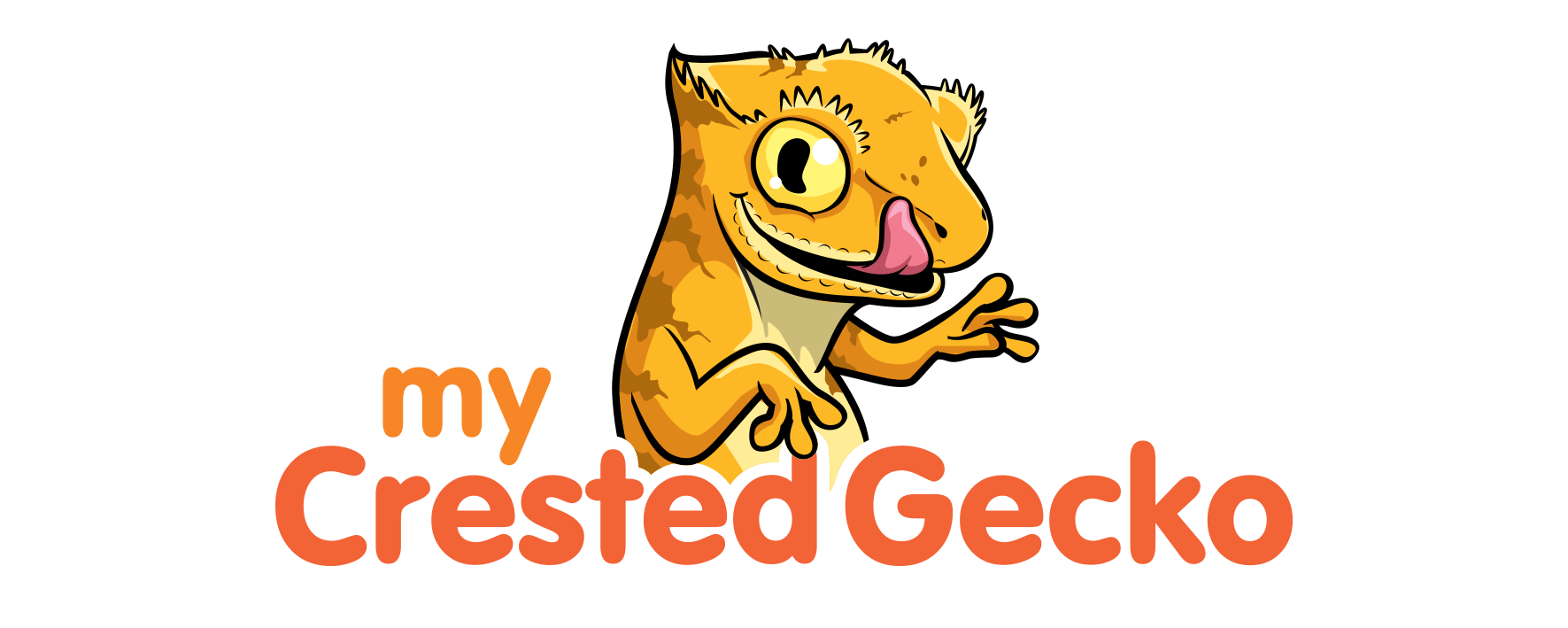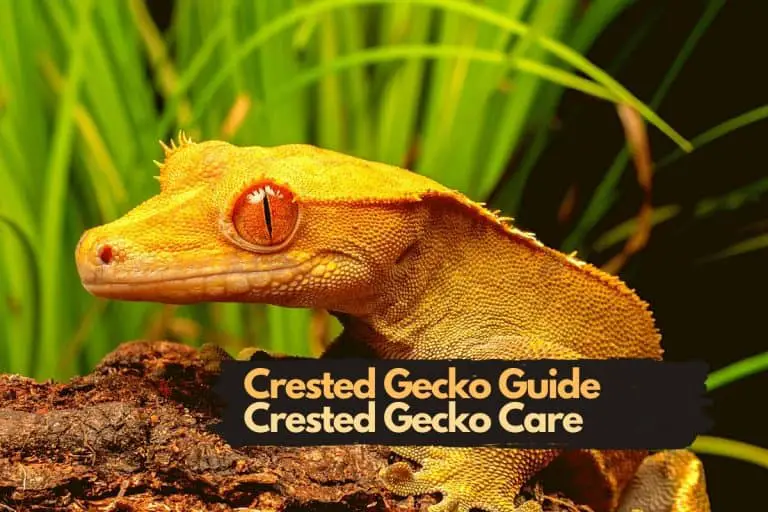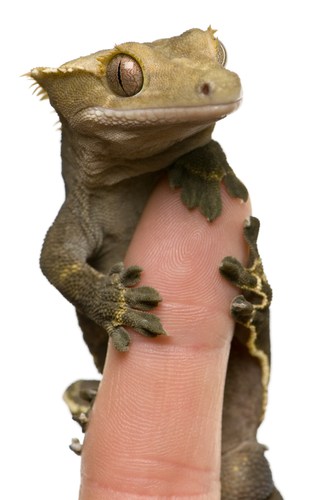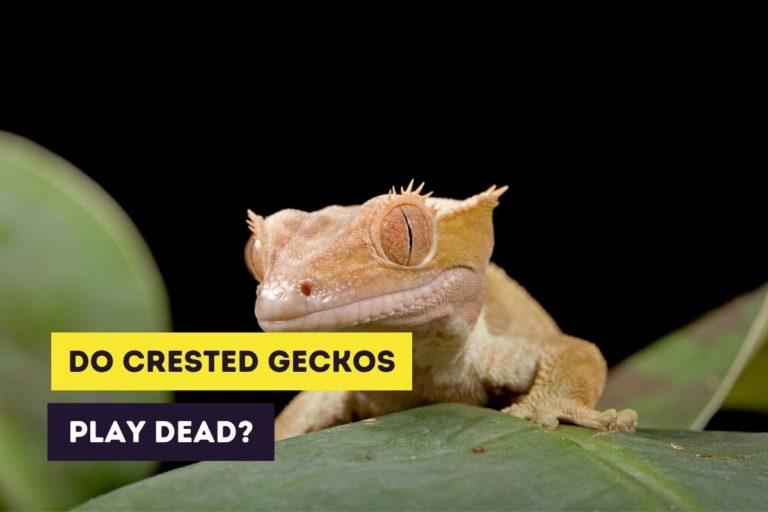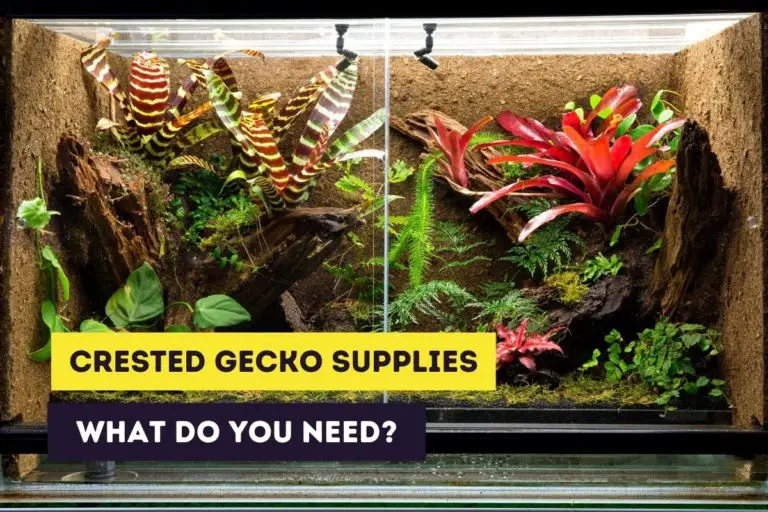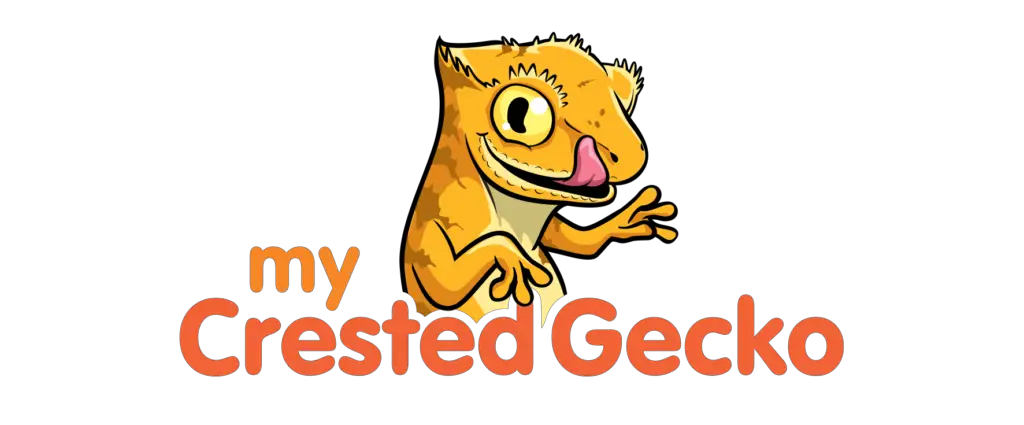Substrates for Crested Geckos: Picking the Best Substrate
Gecko owners used to have a limited range of substrates they could use. They could use old newspapers or mulch. Nowadays we have a lot of different types of substrates available. The type you choose depends on the age, safety concerns and the look you want to achieve.
Picking a good substrate is not easy. You might think that it’s as easy as buying a pack in a pet store and fill the terrarium floor. But if you choose the wrong type of substrate your crestie might end up with health issues.
It’s important to remember that some types of substrates can look really attractive but looks aren’t everything. Always pick the right type of substrate that fits your type of gecko and takes safety into account.
In this article, you’ll learn what a substrate is, what types of substrates are available for reptiles. Next, you’ll learn what substrates you should avoid and what are the best substrates for crested geckos. Finally, you’ll get some tips and tricks for choosing and using substrates in a crested gecko vivarium
If you’re interested in stickers or other products of crested geckos, you can always visit our Etsy Shop, which is called Artful Animalia. We currently only send stickers in the United States. If you’re interested in certain crested gecko-related products, don’t hesitate to contact us.
This site contains affiliate links to products we recommend and use ourselves. We may receive a commission for purchases that you make through these links. If you’re interested in learning more about our affiliate links, please visit our (affiliate) disclaimer.
Introduction to Substrate
What is a substrate?
When the vivarium of your crested gecko is its house, the substrate can be compared to the flooring. The term substrate is used for a wide range of materials. It just means the covering of the bottom of the vivarium. Sometimes substrate is also called bedding or bedding material.
A substrate is used for three primary reasons:
- covering the floor: a vivarium doesn’t need substrate, but it often helps to have a cover over the floor of vivarium to make it easier to clean.
- odor-control: substrates can control the odors of urine and feces.
- absorbing (spilled) water: a vivarium that contains a water bowl can lead to spilled water on the floor. When you mist a vivarium without a substrate, the water will also set on the floor. If you don’t want a pool of water on the floor, you’ll need a substrate.
Besides these reasons, a substrate is also used to have a nice looking – and possibly naturalistic – vivarium.
A little heads up, most brands and manufacturers of substrates won’t call them substrate. The commercial term is usually: litters, bedding mixes, or bedding material.
Is substrate necessary in a crested gecko vivarium?
Technically speaking, you don’t need a substrate in your vivarium. If you have no substrate there is no risk of ingestion and impaction. Having no substrate is also a budget option since you don’t need to spend money on the (sometimes expensive) substrate.
If you choose this option, you do have to clean the vivarium daily, and the floor of it will possibly have little pools of water. A crested gecko vivarium will need a constant humidity higher than 50 percent. This will require regular misting, which will form these small pools. This can also lead to accelerated bacteria growth, which can be prevented with daily cleaning.
Substrate Types
There are a lot of different types of substrates, and not all of them are suitable for all reptiles. Some substrate is more ideal for a dry vivarium, while another substrate is more ideal for a humid vivarium.
The most common substrate types are:
- (news)paper
- carpet
- moss
- mulch
- wood shavings
- soil
Newspaper
If you don’t want to spend a lot of money but don’t want a bare vivarium floor, one of your best options is (old) newspaper. Newspapers are made from wood pulp. They’re one of the oldest and cheapest ways to have a substrate for a vivarium.
Old newspapers are inexpensive and can even be free but will usually need to be replaced daily. Newspapers are absorbent materials and can also absorb waste from reptiles. You won’t need to spot-clean the substrate but can just remove the newspaper and replace it with a new one.
However, there are some concerns with using old newspapers. These concerns are relatively new and have to do with the printer’s ink that’s used. This ink is considered by some to be toxic for reptiles. Nowadays, newspapers are printed using non-toxic inks that are often based on soybeans (soy ink). There is no real concern using old newspapers as a substrate from a safety/toxicity viewpoint.
Carpet
Carpets are another reasonably cheap way to provide a substrate for a vivarium. You can buy carpets in different shades of green. Carpets are soft and can be treated with a waterproof liner to prevent leakage from waste and water.
When you use carpets, you’ll have to take out the carpet and wash it regularly to keep it clean. A carpet can last for a longer time than an old newspaper but it is also a bit more expensive. It’s also best to buy at least two pieces of carpet, so you always have a substrate while washing the dirty carpet.
Carpets can be used in all kinds of vivaria and can even be used as a base substrate with another type of substrate on top of it. A word of caution, when you put carpet under a moist substrate, like moss, this will lead to fast bacterial growth in the carpet.
Moss
Mosses are an excellent substrate for (rain)forest vivaria and smaller lizards. When you’re able to get moss in your area, you can get this kind of substrate without any expenses. However, most people will get mosses from a store.
Moss looks very natural and is great to create a vivarium with a medium to high humidity. This type of substrate is also very soft but does have a slow growth rate. Moss also prevents erosion.
The most common type of moss that is being used as a substrate is spaghnum moss (also sometimes called living moss). This moss is usually available in the form of flat sheets or small bales. The love for spaghnum moss by a lot of lizard owners comes from the ability of this moss to hold large amounts of water and create a naturalistic vivarium.
Spaghnum moss not only holds water well. It is also a great way to maintain a slightly acid pH in the soil. The moss releases certain chemicals that reduce the growth of bacteria this way. However, it’s often a more expensive substrate, and some users have noticed severe fungal infections when using spaghnum moss.
Sometimes spaghnum moss is confused with peat moss. Peat moss is derived from spaghnum moss but is not the same. It’s, in fact, the dead moss that’s dried and grinded. Peat moss is often used for potting plants and can also act as a natural fertilizer. While spaghnum moss is live (green) moss, peat moss is dried and grinded (dead) moss. But, as I already mentioned, both terms are often used for live spaghnum moss.
Coconut bedding (husk/coir)
A special kind of substrate that’s being marketed is made of coconuts. The chopped and processed hairs of the coconut husk are sold as a substrate for reptiles. Besides that, the processed coconut shell is also sometimes used as a substrate.
These coconut husks have proper absorption but are relatively unexplored as a substrate and are less popular as a substrate than the other substrate types I already mentioned.
(Reprocessed) paper
Bedding material made of (reprocessed) paper is popular for pet rodents but is also available as a substrate for reptiles. This paper substrate has high absorbent properties but is too expensive and will break down. The paper is also a light and sometimes dusty material.
You can, in fact, use all kinds of papers like old newspapers or paper towels. There are even commercial paper cage liners available.
Mulch
Mulch, like cypress mulch, is one of the most popular substrates for reptiles. The mulch is usually of uniform size and creates a natural-looking vivarium. Mulch is a biodegradable substrate that can easily be used in your garden after use.
Mulch has a high absorption rate and can retain a lot of waste before it has to be changed. It also has a fresh – foresty – smell and is available as fine mulch or in chips. However, there is a risk that the mulch still contains sharp pieces that can cause harm to you or your gecko.
Mulch can get too moist and needs to be checked regularly. When there are too many bacteria, a particular sour smell can be noticed, which is a sure sign that the mulch needs to be replaced. I say replaced because cleaning mulch isn’t easy so you’ll need to replace the mulch after a while.
Wood shavings
Pine and aspen wood shavings are another widely used substrate for reptiles. These shavings are heat-treated to remove toxic oils as much as possible. Aspen shavings are better than pine shavings because they’re nearly dust-free, don’t contain toxic chemicals, and have a more uniform shape. However, aspen shavings are more expensive than pine shaving.
Wood shavings look natural and absorb water and waste well without a particular smell. They’re also cheap enough to replace when you need to clean the cage.
Cedar shavings should never be used as they contain volatile oils that possess a distinctive smell. These shavings can cause kidney and respiratory problems when used in a closed environment as a vivarium.
Soil
One of the best and most used substrates for crested geckos is soil. You can make a soil substrate by using the soil in your own backyard, or you can choose to purchase organic soil from a store.
When choosing a soil substrate, absolutely avoid products that contain vermiculite, perlite, manure, fertilizers, and herbicides. Vermiculite and perlite can cause impaction when ingested by your crestie. Herbicides, manure, and fertilizers contain chemicals that are toxic to reptiles.
Bark
Bark is a low-cost substrate that is widely used in terrariums. It’s a good-looking substrate that creates a natural look in the terrarium. The bark of the fir tree is commonly used and is also used to cultivate orchids. Another name for fir bark is orchid bark. Bark has a low ingestion risk – but it is still possible to ingest – and is excellent to absorb water in high humidity terrariums.
Fir bark is easy to clean, but you’ll need to replace it every month. This can be a real drawback as fir bark can get expensive in some parts of Europe and the US.
Best Substrate for Crested Geckos
Best substrate for hatchlings and juvenile crested geckos
Hatchlings and juvenile crested geckos are tiny and have a higher ingestion risk than adult geckos. Your substrate should have a low ingestion risk and should be able to be cleaned easily.
For hatchlings and juvenile cresties, I recommend using:
- no substrate: no substrate means no ingestion risk, but the container or vivarium will need to be cleaned daily to avoid the buildup of bacteria and water.
- paper substrates: old newspapers or paper towels work well as substrates for hatchlings and juveniles. When you notice that your geckos rip the paper and try to eat it, you can opt for butcher paper, which is sturdier and is less likely to tear.
Best substrate for adult crested geckos
Adult crested geckos (around 18 months) will still have an ingestion risk but can be safely kept in a vivarium with a good substrate. When choosing a good substrate, you’ll need to get one that:
- can be used in a high humidity vivarium,
- has a low ingestion risk,
- is easy to replace or clean.
Is there one ideal substrate?
There’s not one single ideal substrate for adult crested geckos. It’s entirely up to you to choose the substrate that works best for you. To give you an idea of the best and most commonly used substrates for crested geckos, here’s a helpful list:
- spaghnum moss
- cypress mulch
- coconut bedding (coir/husk)
- organic soil mix
These substrates are best used in combination with each other. For example, a coconut bedding can be combined with cypress mulch or an organic soil mix to provide the best substrate and growing medium for plans.
What about bioactive substrate?
If you’re looking for the best natural substrate, I would recommend getting a bioactive substrate. This kind of substrate is a mix of all types of natural substrates and will last for several months before replacement is needed.
A suitable bioactive substrate consists of:
- a solid base of potting soil: use 40 to 50 percent organic potting soil without fertilizers, perlite, or vermiculite.
- elements to give structure and water-retentive properties: use 10 percent peat moss (if not already added in the potting soil) and 30 percent coconut husk or coir.
- elements to create a well-draining substrate: use 10 percent sand, 5 percent orchid bark, and 5 percent cypress mulch.
This substrate should be damp and should be sprayed with water regularly. Don’t overdo it and avoid making the substrate wet and soggy.
Substrates to Avoid
Crested geckos need a humid (rain)forest vivarium. So, some of the substrates I mentioned above are not suitable for crested geckos and need to be avoided to prevent health issues.
You should avoid using the following types of substrates:
- cedar wood shavings: these shavings contain toxic chemicals that can cause health issues in a closed environment like a vivarium.
- animal litter: a lot of litters, like cat litter, consist of granulated parts that can hurt your gecko and are easily ingested. Ingestion of the highly absorbent litter will lead to impaction.
- (reptile) sand: sand is dusty and will stick to your crested gecko easily. When feeding insects, the sand will also adhere to the insects and will then be ingested by your crestie. However, non-toxic play sand can be used in small amounts in a mix.
- non-organic potting soil: potting soil contains a lot of dangerous chemicals like perlite that cause health problems when ingested.
- gravel and pebbles: these must be washed when soiled, which is a time-consuming task. Besides that, they don’t create a natural-looking (rain)forest vivarium.
- (reptile) carpets: carpets are difficult to keep clean in a high-humidity vivarium, and the treads might come loose and constrict your crested gecko.
Tips and Tricks for Using Substrate
Now that you know what substrate you can use and what kind you should avoid, here are some final tips and tricks for you to get the best and safest experience:
- ingestion risk: when using a substrate, you should always make sure that the risk of ingesting substrate is minimal. You can minimalize this risk by using a food and water bowl. When you feed insects, you should feed them in a separate container. Most ingestion of the substrate is caused by accidentally eating it instead of the insect.
- hiding places: the substrate is an excellent hiding place for feeder insects. Insects can hide under paper towels or in soil or mulch. Since feeder insects can be harmful to a crested gecko, you should make sure that they can’t hide well in the substrate. This is another reason for feeding living insects in a separate container.
- use a sifting screen: a screen can help sift out large particles from the substrate. Coconut bedding, for example, contains large particles that can cause impaction. When you use a sifting screen, you can possibly avoid this.
- covering the substrate: to create a naturalistic vivarium you can add a leaf cover (just use leaves you find outdoors) or spaghnum moss on top of the substrate. This cover prevents the accidental ingestion of the substrate and provides more water retention to the substrate.
- no dangerous chemicals: when buying substrate, in particular soil, make sure to avoid substrates that contain perlite, manure, fertilizers, herbicides or other chemical additives.
- layering substrate: you should layer the substrate over the entirety of the vivarium. The layer should have a thickness between 2 and 4 inches (5 to 10 cm).
Want to Learn More?
If you want to learn more about crested geckos as pets, please read the following articles.
If you’re interested in getting crested geckos as pets you should also definitely read our article about baby and juvenile crested gecko care or (adult) crested gecko care.
